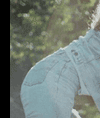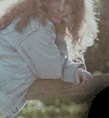|
| Creativity & innovation |
is a way of life.
|
First manifestations in childhood were sewing,
embroidery, drawing, painting &
sculpture.
The journey of maturation proceeded through...saw it progress through
...
|
The journey through a variety of fascinating fields
returned me to the earth where interests & experience coalesced
to run a farm of diverse livestock & topography.
It harbors a studio where the origins of my journey are rediscovered
in sculpture, portraits of people, animals & the useful application of my infatuation
with life. |

I was taught to write and draw as soon as I could
hold a pencil. In the solitude of my oriental childhood, art constituted
an important part of life and panacea for any malaise or upset. The
only places I was permitted free rein were museums. In those days
artifacts lay on open shelves, available for close examination. The
curators took me under their wing, teaching me about everything before
me, thereby linking art to everything in life. I was enthralled by
the same qualities that had inspired the artist 4,000 years before.
The impact was visceral. Throughout my travels, museums and galleries
were my ultimate objectives. They taught me history, science, humanity,
psychology, diplomacy, humour, engineering,
I love art as a means of communication through time and space and
I studied diligently to understand the conceptual, minimal, post modern,
intellectual, formalist concerns of the day. The thought of an archeologist,
centuries hence, discovering an artifact of our time brought me back
to my original belief - that lines and forms discern sentiments that
transcend time and space. They move us … define art…and
project a sense of immortality.
My first work was exhibited at school, after which I was invited to
exhibit with different artists annually. By the time I was eighteen
my scientific illustrations had been published. My studies of people
and animals had won prizes, been exhibited and sold in five countries.
I was invited to give talks and participate in seminars and to teach.
In the early seventies I co-founded art groups and worked to bring
artists and their art to the community. In 1972 I established Atelier
Kralik in Ottawa. For 28 years, artists from many countries and disciplines
congregated there and exhibited their work.
The concept of the Renaissance was alive in my family and it was one’s
duty to develop as many facets and abilities as possible. |


| As a student, my favourite subjects were physics,
chemistry, botany, zoology; all of which introduced me to people who
were involved in research. They required detailed technical drawings
to illustrate reports and papers published about their discoveries.
I drew plants, insects, biology dissections and eventually worked
with a microscope to detail sections. I loved this work, intending
to study medicine to become a medical illustrator. |

My first position after High School was as a commercial
artist for Bell Telephone. I was accepted on the basis of my portfolio.
I began my “on the job” education, in which every assignment
was a test and failure was not an option. My client base was extensive
and covered every field. I developed an open-minded approach and cultivated
a versatility that served me throughout my career.
I researched all unfamiliar subject matter in order to depict it dynamically
as well as physically correctly. The experience allowed me to perfect
my skills in lettering, typographic design, line drawing, composition,
logo design and public relations. |

| From 1965-9, I studied architectural drafting, rendering,
photography and maquette building. These disciplines were fascinating
and invaluable from that point on. |


| Among the first skills I was taught as a child were
the arts of clothing design, tailoring, embroidery and lace. My designs
were especially in demand during the sixties when people threw convention
to the wind, outdoing each other in their search for something especially
daring and innovative to wear to the annual balls, the opening of
Parliament, traveling or other special events around Ottawa. |

| As associate in an advertising firm, I carried out
projects in typographic design, publications design and corporate
image design. Clients included Dundas Chemical, Insulglass, Pure Spring,
The Seaway Authority, Assaly Construction, Bill Teron, Minto, Campeau
and 3M. It was very exciting work, as yet unaffected by the technology
revolution. Concepts relied on manual skills that took years to master
but resulted in unique products. This process was quite unlike the
mechanical / computer driven graphics that soon followed which enabled
people lacking design skills and aesthetic sense to generate graphics.
|


Forms Design offered me the opportunity to apply
my widening experience in an area that had little competition and
provided an enormous challenge. In 1970 I won a competition to Nutrition
Canada, an ambitious Federal project to ascertain the relationship
between health, geography, socio-economic status, employment and other
factors.
Success relied on the use of huge mainframe computers that required
entire buildings of their own, scores of programmers feeding truckloads
of punch cards into them and reviewing trainloads of paper that spewed
forth from them each day. It was a heroic undertaking that introduced
me to a diverse team of specialized professionals united in a groundbreaking
project. I reveled in the breakneck intensity of research and collaborative,
innovative problem solving.
I took university courses in computer programming, systems analysis,
statistics and psychology, in order to understand the factors that
influence people’s attitudes to capturing, interpreting and
managing information via computer technology. In fields that normally
rely on narrative, we had to designate conditions, alternatives and
degrees numerically. Without exception, simplification causes complications
and it is complicated to simplify. |

My work with Nutrition Canada opened a door to the
frontier of systems analysis and design. My university studies continued
in the evenings while I learned practical applications in the real
world during the day.
I set up paperwork processing systems for Health & Welfare Canada,
Medical Services, Agriculture Canada, Indian & Northern Affairs,
Parks Canada, & Environment Canada. I trained individuals, organized
seminars, all the while crusading for work simplification and the
elimination of duplication. |


Many of the Management engineers in Government came
from the military during the seventies. I was always the first or
the only female consultant they worked with. I was fortunate to be
surrounded with strong players who were instrumental in groundbreaking
management innovation in the private sector. They were excellent mentors.
The projects assigned to me were in fields of science, medicine, health
and agriculture; all of which fascinated me. I particularly enjoyed
collaborating with subject specialists and researching in the departmental
libraries and archives. Although each project was different, they
all required creativity in problem solving and the ability to realize
implementation.
My projects included systems analysis and design, performance measurement,
organizational design, public relations, conference planning, communications
and a multitude of management improvement initiatives.
Within a decade, the sudden influx of MBA graduates inundated management
and taught me how destructive empty lessons devoid of practical experience
could be to an organization. |

| Most of my positions required a writing style that
is detailed, succinct and interesting to read. The years of copy writing
for advertising, promotion, for press releases, for printing or for
building specifications proved a fine training ground for writing
reports, executive summaries, systems and procedures manuals. Later,
I wrote about artists and their work. |


| The study of ballet, music and theatre dominated
my early years, culminating in roles in “After this, our Exile”,
“Our Hearts Were Young and Gay” and Dylan Thomas’
“Under Milkwood”. |

| Promoting bands, making demo tapes, intros to the
recording industry, etc. |

| Tiraislin farm began in 1996 as my magnum
opus, my performance piece, my exploration into cycles of life
that make sense. It demanded of me all the faculties
I’d spent a lifetime acquiring. In return, bliss, exhaustion,
an endless supply of subjects, resources, space and
potentially, wisdom. The animals teach me by their
interactions, a way to live more interesting & pleasant than
the savagery of urban life.
The promise I make to the animals is that they have the
happiest life they can have. They are free to gambol in
the sun and forage. I believe the meat from pasture raised
animals is far more delicious & healthy. CLA, which protects
the animal from disease as well as the person who eats the
meat, drinks the milk or eats the eggs, is higher in pasture
raised animals and disappears in confined animals. T he meat
from pasture raised animals is much leaner which in turn can
sometimes be tougher than the pulpy flesh of animals which
have spent their lives confined & unable to move. The flavour
warrants taking care to cook the meat gently. It is lean
enough one can afford to cook it in butter or olive oil. It is
so rich that one is satisfied without overeating.
I also believe that we are a complex bag of chemicals in
which happiness is the result of a certain combination. I
suspect that if we eat the meat of tortured creatures who've
known nothing but the pain & frustration of not being able to
move, run, roll in the sun, stretch out, experience play &
grooming with friends & relations or even choose its own
fodder, then we suffer too.
I believe our state of being affects the way we grow at the
cellular level. This pain or bliss affects our very
fibres. Therefore, in my mind, the widespread depression in
today's population is not a coincidence.
Visitors come to study, work, realize special projects,
repair urban frazzle …or just marvel at nature. |
|
|

|









